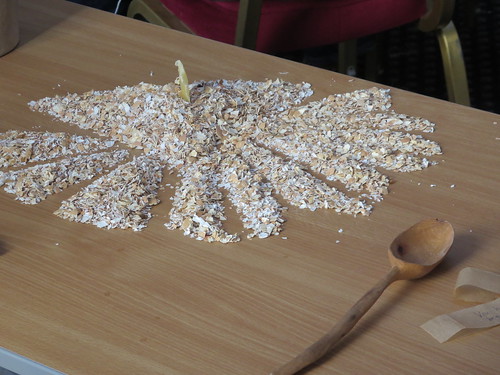Diversity is an issue that the Cabot Institute team discuss a lot. Out of a concern for the lack of inclusion in Bristol’s ‘green scene’, we awarded Innovation Funds to the brilliant Green and Black Ambassadors’ project to support two black women to develop their (already inspiring) leadership and begin to build a more inclusive environmental community. We’ve refused to participate in, or cancelled, events that didn’t have diversity in the speaker list. And we feel proud to have the first female president of the Royal Meteorological Society as the Chair of our Board.
Whilst small, these actions require individual and collective consciousness embedded in everyday decisions.
But for all our caring and progress to date, we know we have not done enough. Not nearly.
The past few weeks have, in honesty, left us reeling. The tragic death of George Floyd, and the widespread #BlackLivesMatter activism that followed have served as a critical and hard-hitting reminder of just how far we have to go – as a society but also as a research Institute. We also know that however much recent events have floored us, it is just a fraction of how our friends of colour, but particularly our black friends, must feel. As an all-white team, we can never fully understand the toll these everyday aggressions and acts of discrimination have. But we can turn our passion and attention to the issue, we can listen and learn, and we can work in earnest to be part of the solution.
First steps
On #BlackoutTuesday we posted the following message on social media.
We stand in solidarity with our black friends, colleagues and role models. Diversity makes us stronger – as a research community, as a city, and as a society. #blacklivesmatter pic.twitter.com/k4T0avkgRl— Cabot Institute for the Environment🏳️🌈✊🏿✊🏾✊🏽 (@cabotinstitute) June 2, 2020
It felt essential to publicly stand with our black colleagues, friends and role models and note our solidarity. However, we were well aware that this might be perceived as tokenistic, or worse, hijacking a sincere campaign with insincere ‘marketing’ if our statement was made in the absence of action. In posting this, we also committed to discussing what practical steps we might take to make real progress.
Actions, not words
The result of our conversations have now been released in a public statement outlining some of the steps we commit to taking in pursuit of a more diverse, inclusive, and equitable environmental research community.
Read our public statement on Black Lives Matter.
We will soon issue a formal invitation for individuals to join our working group, to which we will particularly encourage participation of BAME, LGBTQ+ and other underrepresented groups. However, we recognise that in doing so we are calling on the time and emotional resources of underrepresented communities to fix a problem that should be ‘owned’ by others. We will strive to get the balance right.
We invite anyone who wants to support our review, or the actions resulting from it, or even to offer feedback, to contact us at cabot-enquiries@bristol.ac.uk.
Let’s not wait
Whilst a measured review will provide the most sensible starting point for meaningful action, we were keen to set a number of balls rolling as quickly as we could. To date, members of the team have:
- Contacted the leads of the Cabot Project, who have very helpfully sent us some resources on the history of John Cabot.
- Identified other papers which shed light on John’s history and the implications for environmental justice.
- Identified scholarships which could specifically support BAME candidates to join our Master’s by Research programme and begun promoting these.
- Initiated a review of our online communications materials to explore how many projects or news items profile people of colour.
- Contacted UoB Business Analysts to assess the diversity of our environmental community and provide crucial analysis to inform the working group once established.
- Our theme leaders for Natural Hazards – Dann Mitchell and Ryerson Christie – have confirmed their support of the ‘Statement on Systemic Racism and Disasters’ from the North American Alliance of Hazards and Disaster Research Institutes (NAAHDRI) condemning violence and systemic racism
- All University Research Institute Directors have signed an email to the University leadership in addition to the broader ‘decolonise the University’ campaign, calling for a change to the University logo.
We have only just begun, and there will be many holes in the plans we have laid out. Many nuances missed. Many opportunities for us to improve. We welcome feedback and critique from you all to help guide and shape our efforts. With many minds, and many perspectives, we can and will make a difference.
In closing, I want to say two things. First, an enormous thank you to the Cabot Team. Whilst we are realistic that we have a mountain to climb and much to learn, the intense debate and discussion catalysed with you all in these past weeks gives me hope. I’m so incredibly fortunate to work with a team who care deeply about inclusion. Your willingness to be vocal about the need to change, to openly and kindly challenge one another to be better, and proactively consider how you can help build a better and more inclusive research Institute inspires me no end. It has also taught me the importance of that crucial ‘first conversation’. It was Mand (Amanda Woodman-Hardy) who sent an (possibly out of hours) email to the team noting her discomfort with our silence on #BlackLivesMatter that kick-started a sincere and engaged conversation.
So to the second point – be the person who starts the conversation in your team, in your family, in your friendship group. These conversations can be emotive, challenging, and uncomfortable, but they can also be energising and hopeful. Either way, they are crucial, and I for one, will be challenging myself to #BeMoreMand* in the months and years ahead.
*Edit: After reviewing this blog post, Mand noted her discomfort at making this about her – a white person. We do need to value the personal leadership of white colleagues in being vocal & challenging the status quo – after all, we simply cannot expect those most affected to be the ones forced to speak up. However, I recognise this discomfort. It is essential that the voices of people of colour are elevated at this time. It is these perspectives that matter, these perspectives we should hear. As such, I include below (with thanks to colleagues at the Centre for Black Humanities for sharing on twitter, and to colleagues at the School of Geographical Sciences for emailing) a small list of inspiring and important resources developed/ written by people of colour. We will aim to share a much wider list of resources in a separate thread.
- Why I am no longer talking to white people about race. (2017) by R. Eddo-Lodge, R. 2017
- Natives: race and class in the ruins of empire (2018) by Akala
- Black Nature, edited by Camille T. Dungy
- Epistemic Freedom in Africa (2018) by Sabelo J. Ndlovu-Gatsheni
- From #BlackLivesMatter to Black Liberation’ (2016) by Keeanga-Yamahtta Taylor
- Passion: Discourses on Blackwomen’s Creativity (1990), edited by Maud Sulter
- There Ain’t No Black in the Union Jack (1987) by Paul Gilroy
You may also wish to begin following the those on the ‘powerlist’ of Bristol’s most influential Black and Minority Ethnic individuals (as voted for by the people of Bristol), or connect with the following organisations: Stand Up To Racism, Black Lives Matter UK @BLMUK , Black Lives Matter @Blklivesmatter, Southall Black Sisters, The British Blacklist, Show Racism The Red Card, Runnymede Trust, Stephen Lawrence Charitable Trust, SARI: Stand Against Racism and Inequality, 4FrontProject @4FrontProject , Inquest @INQUEST_ORG, The Joint Council for the Welfare of Immigrants @JCWI_UK, United Friends and Family Campaign @UFFCampaign, Black South West Network @BlackSWNet.
I add this edit to reflect the way we are all challenging and learning in real time. We won’t get it right all the time, but through discussion, we will get it right more of the time.
——————————-
This blog is written by Hayley Shaw, Manager of the Cabot Institute for the Environment at the University of Bristol.







